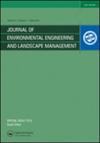硝化粉煤灰好氧处理高浓度废水硝化模型的构建
IF 1.1
4区 环境科学与生态学
Q4 ENVIRONMENTAL SCIENCES
Journal of Environmental Engineering and Landscape Management
Pub Date : 2022-12-16
DOI:10.3846/jeelm.2022.18061
引用次数: 0
摘要
氮化载体可以提供良好的沉降能力和稳定的脱氮效率。硝化载体的氨去除率模型将改善其工程应用。本研究采用Monod模型在粉煤灰硝化系统中进行。结果表明,在Monod模型中,NH4+-N的最大去除率和半饱和常数分别为110.48mg/L和59.19mg/L。引入包括pH、温度和溶解氧(DO)浓度在内的校正系数,将实验数据与模拟数据之间的平均差距从6.48缩小到2.74mg N/(L·h)。当进水NH4+-N浓度从443.18增加到1121.29mg/L时,实验和模拟NH4+-N去除率的差异在0.08mg N/(L·h)到8.34mg N/(L.h)之间。高浓度氨水处理废水,实验数据与模拟数据的不一致性仅为0.08%。然而,当进水平均COD为173.19 mg/L和N为37.20 mg/L时,硝化煤灰对NH4+-N的去除率被抑制了约40%,因此,在处理有机废水时,需要在Monod模型中引入其他因素,例如硝化细菌的含量。本文章由计算机程序翻译,如有差异,请以英文原文为准。
CONSTRUCTION OF NITRIFICATION MODEL WITH NITRIFYING COAL ASH IN AEROBIC TREATMENT OF HIGH STRENGTH WASTEWATER
Nitrifying carriers can provide good settle ability and stable removal efficiency for nitrogen. Models for ammonia removal rate for nitrifying carriers will improve its engineering application. This study was conducted in nitrifying coal ash system with Monod model. Results indicated the maximum NH4+-N removal rate and half-saturation constant of NH4+-N in Monod model were 110.48 mg/L and 59.19 mg/L, respectively. Introduction of the correction coefficients, including pH, temperature and dissolved oxygen (DO) concentration, decreased the average gap between experiment data and simulated data from 6.48 to 2.74 mg N/(L·h). And improved accuracy of the Monod model by 5.11%. The differences between experiment and simulated NH4+-N removal rate ranged from 0.08 mg N/(L·h) to 8.34 mg N/(L·h) when the influent concentration of NH4+-N increased from 443.18 to 1121.29 mg N/L and without organic. Only 0.08% inconsistency between experiment and simulated data occurred in treating wastewater with high-strength ammonia. However, NH4+-N removal rate of the nitrifying coal ash was inhibited about 40% when influent with averaged 173.19 mg COD/L and 37.20 mg N/L, therefore, other factors, the content of nitrifying bacteria for example, need to be introduced into the Monod model when treating organic wastewater.
求助全文
通过发布文献求助,成功后即可免费获取论文全文。
去求助
来源期刊
CiteScore
1.90
自引率
7.70%
发文量
41
审稿时长
>12 weeks
期刊介绍:
The Journal of Environmental Engineering and Landscape Management publishes original research about the environment with emphasis on sustainability.

 求助内容:
求助内容: 应助结果提醒方式:
应助结果提醒方式:


